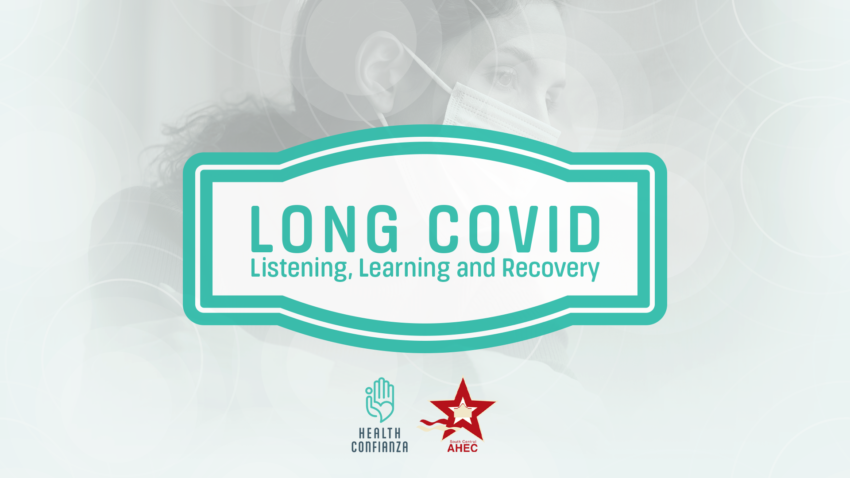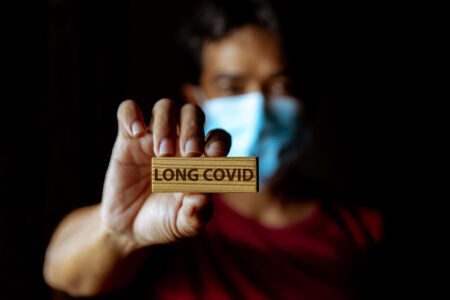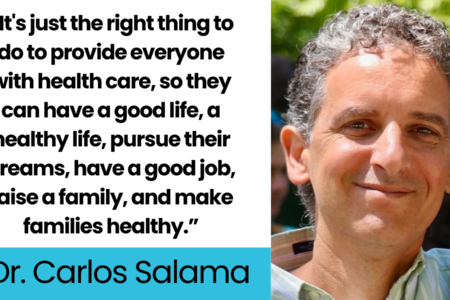
Share On Social!
It wasn’t too long ago that COVID-19 threw life into chaos.
Businesses shut their doors. Food and supplies ran low. We were separated from our loved ones and trapped indoors. Hospitals dealt with rising demand. Lives were lost.
Years have passed since the pandemic and we’ve tried to distance ourselves from a time when distillers halted production to make hand sanitizer, grocery stores had lanes, and smiles were hidden behind masks.
However, some are still living with a constant reminder of that time.
For those with Long COVID-19, time hasn’t healed the wounds of the past as they still try to recover from the physical, mental, and emotional traumas of the condition.
That’s why Health Confianza — a Bexar County health literacy initiative housed at The University of Texas Health Science Center at San Antonio — is sharing the stories of those struggling with the long-term effects of the coronavirus in a new video web series called “Long COVID: Listening, Learning and Recovery.”
The story video series is part of Health Confianza’s partnership with South Central AHEC (Area Health Education Center) to create helpful resources, which also includes documents, articles, and podcasts that may prove helpful to health providers, caregivers, and those suffering with Long COVID-19.
Let’s dive into Long COVID-19 and the new story series.
Long COVID-19
Long COVID-19 refers to the health issues that occur or persist after having COVID-19.
These symptoms can impact an individual for four weeks or more, and just like the illness, Long COVID-19 affects everyone differently with symptoms ranging in severity.
Some of the more common symptoms are fatigue, brain fog, headaches, loss or change in smell and/or taste, hair loss, muscle and joint pain, trouble sleeping, and more, according to Yale Medicine. Other symptoms are rapid heartbeat and palpitations, pain and swelling in the limbs, dental problems, shortness of breath, hearing loss, skin rashes, and more.
Eva’s Story: Long COVID-19 and Psoriasis

One of Health Confianza’s video stories highlights Eva’s struggle with psoriasis, which is a chronic disease that causes scaly and inflamed skin all over the body, following a COVID-19 infection.
The condition felt isolating and caused a strain on Eva’s relationships, but she has since developed a strong support system that’s helped in many ways.
“First, I was embarrassed to come out and say anything. Mostly because it was showing on my body, it was showing on my face, it was showing on my arms. I was more embarrassed for them to see me, [but] knowing that they were there supporting me made a big difference in my life,” Eva said.
Eddie’s Story: Long COVID-19 and Chronic Health Issues
As a result of the infection, those struggling with Long COVID-19 can even develop new health conditions and put them at risk for illnesses like acute respiratory distress syndrome, sepsis, and chronic critical illness, according to Health Confianza.

These conditions can result in damage to the person’s organs and impact autoimmune responses.
Long-term complications from COVID-19 may also exacerbate pre-existing health conditions like diabetes.
When 53-year-old Eddie contracted the COVID-19 virus he experienced more severe symptoms than the rest of his family members.
Eddie went from having fever and body aches to kidney pain and neuropathy, where he couldn’t walk 10 feet away without assistance.
After a visit to the doctor, he was placed on steroids.
“They gave me a lot of steroids and when I went home … Instead of giving me insulin … I just went with the steroids, and everything started escalating. My sugar levels went up to 485 and that gave us quite a scare,” Eddie said.
Sandra’s Story: Long COVID-19 and Caregiving

Many lives have been touched by COVID-19, both directly and indirectly with spouses and children unexpectedly becoming caregivers overnight.
That’s what happened to Eddie’s wife, Sandra.
When Eddie returned home from the hospital after battling pneumonia, he was very weak and needed help moving around.
Sandra provided around-the-clock care for him, and the experience strengthened their relationship.
“There’s going to be good days and there’s going to be bad days. Just try to be there for that person as best you can,” she said.
Teresita’s Story: Long COVID-19 and Brain Health

Other Long COVID-19 diagnoses required a more drastic life change, like Teresita, whose wife was diagnosed with life-threatening brain disease due to coronavirus complications.
As a result of her wife’s disease, she developed aphasia, which impacted her speech — an illness that would eventually alter the family’s life as they knew it.
“She had to find a different job, which was very hard on us as a family. Just financially, mentally, and emotionally. She had been at her job for 9 years and … she lost a sense of who she was. We’re still trying to figure out what our new normal is because since she’s had Long COVID it’s completely taking over our life,” Teresita said.
Discover more stories and more helpful information related to Long COVID-19 and health literacy promotion on the Health Confianza website.
Long COVID-19 and Latinos
COVID-19 has left a lasting impact on some Latino families.
For instance, 23% of Latinos living in Colorado are dealing with Long COVID-19 symptoms, according to a survey conducted by the Colorado Latino Policy Agenda, which was cited by Salud America!
In The Bronx, 28% of Latinos are struggling with lingering COVID-19 symptoms.
The burden of dealing with Long COVID-19 has come with many challenges for Latinos, including socioeconomic issues such as finances and job security.
36% of Latinos reported that their savings have dwindled to pay for healthcare costs related to Long COVID-19 while 33% have missed work due to symptoms, missing out on wages needed to pay for care, according to the BSP National Survey of Latino Families, sponsored by Abriendo Puertas/Opening Doors and UnidosUS.
Latino families are also overcome by many mental health issues in the wake of the pandemic, especially children.
Mental illnesses such as anxiety and depression are associated with Long COVID-19 and during the developmental stages of life, children can be more prone to the effects of mental health.
According to Gabriel A. Sanchez, Rubenstein Fellow in Governance Studies at The Brookings Institution, 41% of Latinos expressed concern about their children’s mental health following the pandemic.
Long COVID-19 Treatment
Ethnic and racial inequities can impact access to equitable healthcare, sometimes delaying treatment for health conditions, like Long COVID-19.
While the pandemic may be over, COVID-19 continues to threaten the health of Latinos and all people.

As the threat looms, health experts are trying to understand Long COVID-19 symptoms and risk factors by investing in treatments that may help.
In fact, researchers are already hard at work trying to find Long COVID-19 therapies by hosting studies and clinical trials, which are studies with volunteers that help researchers learn how to slow, manage, and treat different diseases, such as Long COVID-19.
One such study is the National Institutes of Health’s (NIH) RECOVER research study.
Established in 2021, researchers are trying to learn why some people experience Long COVID-19 or develop new or returning symptoms after infection.
The RECOVER research study led to the creation of phase 2 clinical trials to explore at least four potential Long COVID-19 treatments, and the addition of at least seven more to follow, according to a press release.
Treatments will include drugs, biologics, medical devices, and other therapies.
Help researchers learn more about Long COVID-19 by participating in research studies, such as RECOVER, and by enrolling in clinical trials.
FIND A RECOVER TESTING SITE NEAR YOU!
Clinical trials aren’t limited to Long COVID-19, there are clinical trials for conditions like cancer and Alzheimer’s, too.
Search open clinical trials on the Salud America! clinical trials page.
Protect Yourself from COVID-19
While things have returned to a new normal, the threat of COVID-19 lingers.
The best way to protect yourself and children against the coronavirus, which could lead to Long COVID-19, is to get vaccinated.
Despite the number of Latinos who are vaccinated against the virus, there are still many barriers that Latinos face to COVID-19 vaccinations.
That’s why people, like community health worker Martha Castilla, are working hard to spread the vaccination message.
As a promotora, Castilla provides health education to her community, which includes giving out information about vaccines and COVID-19.
“[The COVID-19 vaccine] is important to prevent getting sick, or dying, and not only for ourselves, but think of our families,” Castilla told Salud America! “Because a lot of pain was left with the families from what we went through when the pandemic was stronger, the effects it had on the families and the memories that they have. It was very difficult.”
COVID-19 vaccinations are available for free for adults and children, according to the You’re Covered website from the COVID-19 Vaccine Education and Equity Project.
Use Vaccines.gov to find a location near you and call or visit their website to book your appointment.
For more vaccine information, visit the You’re Covered website in English and Spanish.
By The Numbers
1
out of 10
Pedestrians survive when hit by a car at 40 MPH




As I read the articles, I was wondering IF some classes/workshops on budgeting would be helpful for the Latino families….Along with that, “throw in” some helps in where/how to shop for healthy foods, getting politically involved via the petitions that come our way each day (SNAP and WIC) These are essential programs and getting info regarding how to make one’s voice heard about these programs, especially around Congressional budgeting. It’s something I do as much as I can in order to help with keeping these programs going and improving. Thank you for the info and the opportunity to comment on these important issues for ALL families. As a former director of a homeless shelter for women and children, I had quite an education around the county-side of getting help, and learning to be patient while having to wait. I think shame is also a detriment for folks, having to get “charity” as it’s sometimes called.